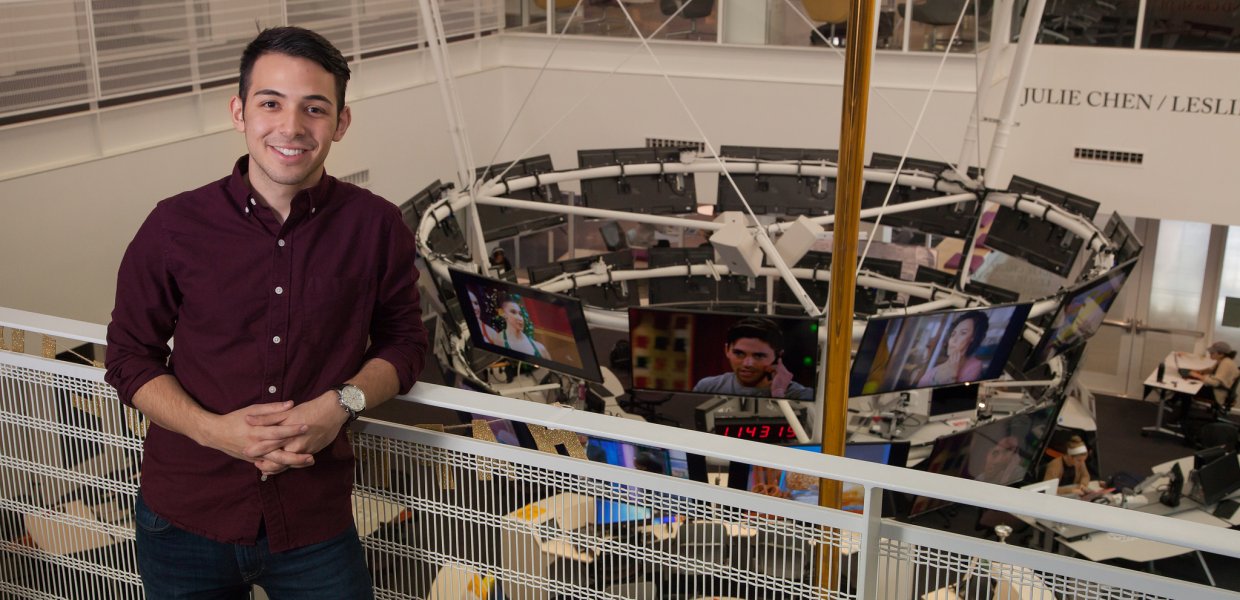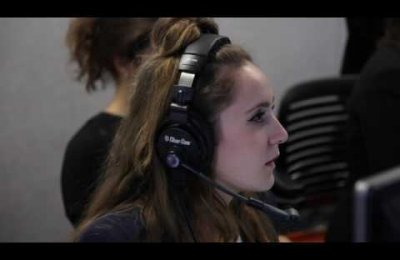When the USC Annenberg Julie Chen/Leslie Moonves and CBS Media Center opened last fall, many of USC Annenberg’s long-running student news organizations — including ATVN, Neon Tommy, and Annenberg Radio News — took up residence in the new space. This fall, the recently-launched Annenberg Media has settled into the Media Center, as well, and though its name is still becoming known around campus, it’s already gained viral fame.
The outlet is the brainchild of senior Fernando Hurtado (Broadcast and Digital Journalism ‘15), and operates in conjunction with JOUR 499: Journalism for Mobile and Emerging Platforms. Both the course and Annenberg Media focus on producing shareable video content and exploring the intersection between news and technology.
Though it has initially served to promote and repurpose content from ATVN, ARN and Neon Tommy, Hurtado said the mission of Annenberg Media moving forward is to offer different perspectives than the other outlets might.
“I try to stay away from the day-of-air mentality that everyone else has just because I know they’re doing that and they’re doing it well. That’s not where I can add value,” said Hurtado, whose official title is Executive Producer of Digital Video and Mobile and Emerging Platforms. “We try to look at other stories that have social media spunk.”
The outlet’s most notable example of “social media spunk” to date is a video that showed a Spanish-speaking and Arabic-speaking student demonstrating the similarities between the two languages. Since its debut in November, the video has amassed more than 15 million views and counting on Facebook, nearly half a million on YouTube, and hundreds of thousands of shares across social media platforms.
The video was pitched and created by student producers Barbara Estrada and Taylor Villanueva. The idea came to Estrada, a junior broadcast journalism major and Spanish-speaker, when she noticed she was able to understand conversations between her roommate and her mother when they spoke Arabic.
Villanueva, whose father speaks Spanish and mother speaks Arabic, had also noticed the similarities between the two languages previously, and thought a short video on the topic would make for a great example of what she calls “snackable” digital content.
Both producers pitched the video to Hurtado, who suggested adding an explainer providing historical context for the languages’ similarities at the end. The video was published on a Thursday, and as the team watched its views increase from a couple of thousand, the most any Annenberg Media video had received previously, to several hundred thousand by Friday and more than a million on Saturday, they realized the video was going viral.
“It was utterly surreal,” Estrada said. “It really put into perspective how the world is so small and something of this magnitude can really bring people together. I think it was so successful because it was so simple and easy for people to digest, and because it was a topic that brought people together.”
The success of the video also came as a shock for Villanueva, a junior broadcast journalism major, who attributes much of its appeal to the way it seems to have bridged cultural divides.
“I think people liked the video because it would connect one person to his or her friend of a different culture,” Villanueva said. “I think personally, being both Mexican and Lebanese, it was also nice to see a video that showed the cultures that speak these languages in a positive light.”
The video has provided a massive boost for Annenberg Media’s social media presence — its Facebook page has been “liked” more than 30,000 times — which is fitting considering harnessing the power of social media is what the organization is all about.
“It really resonated with the audience,” Hurtado said. “I was really scared that people were just going to like the video and that was as far as engagement would go, but they liked the page, and a lot of the likes transferred over to our other content.”
Hurtado said the video also served to increase awareness of Annenberg Media on campus. He now receives more emails from people looking to join the team, and its success has contributed to what he calls a “seamless” collaboration between the Media Center news outlets this semester. Under Hurtado’s leadership, with support from graduate student Monica Castillo, who acts as Annenberg Media’s manager, the team’s 29 producers work in shifts to create content for various platforms.
On the faculty side, professor and ATVN associate director Rebecca Haggerty serves as faculty advisor at the Annenberg Media Center, and co-teaches JOUR 499 with professor Amara Aguilar. The class launched with four students this fall, but is already full for the spring semester, with 12 students registered.
A former Dateline NBC producer with a background in digital media, Haggerty said the idea for creating a unit producing native contentfor social media grew from student interest and faculty collaboration.
“It was really about helping our students experiment with the best ways to create content,” Haggerty said. “It’s increasingly important in the industry and we want to prepare students for jobs, and make sure they have a wide range of skills. It’s important especially for younger generations because these platforms are where people get a lot of their news.”
Haggerty said she was initially a little skeptical that the Spanish-Arabic comparison video would appeal to a broad audience, but attributes its success to the fact that Estrada and Villanueva were able to make the video factually sound and informative while also being engaging.
“It still uses a lot of fundamentals that good journalism has always used,” Haggerty said. “The other lesson is you never know what’s going to go viral. We’re still seeing several times a day people commenting on it and they’re really engaging with it, so it really struck a chord.”
For Aguilar, who has seen the Annenberg Media team grow from a beta unit to the 29-person operation it is today, the viral video represented a semester of hard work, and students who have been eager to learn the ins and outs of digital media. While Haggerty provides support for students in the Media Center, Aguilar brings her digital expertise to the classroom, and also helped coin the Annenberg Media unit’s nickname.
“Our class is called journalism for mobile and emerging platforms, so we said we need to make this something else because it doesn’t roll off the tongue,” Aguilar said. “Some of us are Star Wars nerds, so we said, let's called it the JEDI team, which stands for journalism and emerging digital innovation, and that caught on.”
The class has featured a number of guest speakers from high-profile media and technology companies, offering insight that reinforced the type of content Annenberg Media is exploring.
“It was really cool to see that at times the work we were doing was exactly what people in the industry have started to do,” Hurtado said. “In a few instances it kind of seemed like we were even ahead of them.”
In addition to short, shareable videos, Annenberg Media created two semester-long, “Humans of New York”-style photos and video series, one focusing on diversity at USC, and the other on girls in sports. Annenberg Media has also been quick to utilize live-streaming platforms, and recently used Periscope and YouTube Live to stream an Ask Me Anything Q-and-A session with student body president Rini Sampath. Hurtado said looking forward, he sees the outlet further developing its mini documentary unit, and designating dedicated editors for each social media platform.
Annenberg Media’s incoming Executive Producer, Kevin McAllister, a junior majoring in Broadcast Journalism and Political Science, is already looking toward optimizing the outlet’s growth in the spring semester and beyond. In determining the next steps for the unit, McAllister said having a viral video under Annenberg Media’s belt has helped in more ways than one.
“Looking forward I’m excited to not just continue what we’ve been doing but now craft our brand a little bit more,” McAllister said. “This semester was incredibly important because now we’ve built a base audience and in a way that I would never have really imagined.”








